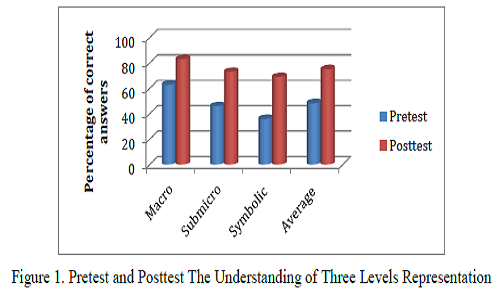
The Urgency of Implementation RADEC Learning Model to Understanding of Three Levels Representation in Chemistry Learning: Literature Review
Abstract
Keywords
Full Text:
PDFReferences
Anam, R. S., Widodo, A., Sopandi, W., & Wu, H. K. (2019). Developing a five-tier diagnostic test to identify students’ misconceptions in science: an example of the heat transfer concepts. Elementary Education Online, 18(3), 1014–1029. https://doi.org/10.17051/ilkonline.2019.609690
Ayas, A., Özmen, H. & Çalik, M. (2010). Students’ Conceptions of The Particulate Nature of Matter at Secondary and Tertiary Level. International Journal of Science and Mathematics Education, 8, 165-184. https://doi.org/10.1007/s10763-009-9167-x
Çil, E. (2015). Effect of Two-tier Diagnostic Tests on Promoting Learners’ Conceptual Understanding of Variables in Conducting Scientific Experiments. Applied Measurement in Education, 28(4), 253–273. https://doi.org/10.1080/08957347.2015.1064124
Creswell, J.,W. (2012). Educational Reasearch: Planning, Conducting, and Evaluting Quantitative and Qualitive Research 4th Edition. Boston: Pearson
Fraenkel, J. R., & Wallen, N. E. (2012). How to Design and Evaluate Research in Education (8th Ed.). New York: McGraw-Hill
Derman, A., & Ebenezer, J. (2018). The Effect of Multiple Representations of Physical and Chemical Changes on the Development of Primary Pre-service Teachers Cognitive Structures. Research in Science Education, 1–27. https://doi.org/10.1007/s11165-018-9744-5
Gilbert & Treagust. (2009). Multiple Representation In Chemical Education: Models And Modeling In Science Education. Springer.pp.251-283. https://doi.org/10.1007/978-1-4020-8872-8_1
Irby, S. M., Phu, A. L., Borda, E. J., Haskell, T. R., & Meyer, Z. (2016). Research and Practice Use of a card sort task to assess students ’ ability to coordinate three levels of representation in chemistry. Chemistry Education Research and Practice. https://doi.org/10.1039/C5RP00150A
Kaltakci-Gurel, D., Eryilmaz, A., & McDermott, L. C. (2017). Development and application of a four-tier test to assess pre-service physics teachers’ misconceptions about geometrical optics. Research in Science and Technological Education, 35(2), 238–260. https://doi.org/10.1080/02635143.2017.1310094
Milenković, D. D., Hrin, T. N., Segedinac, M. D., & Horvat, S. (2016). Development of a Three-Tier Test as a Valid Diagnostic Tool for Identification of Misconceptions Related to Carbohydrates. Journal of Chemical Education, 93(9), 1514–1520. https://doi.org/10.1021/acs.jchemed.6b00261
Pratiwi, I., D. & Laksmiwati, H. (2016). Kepercayaan Diri dan Kemandirian Belajar Pada Peserta didik SMA Negeri “X”. Jurnal Psikologi Teori dan Terapan, 7(1), 43-49 ISSN: 2087-1708.
Sadikin, A., A.Hamida. (2020). Pembelajaran Daring di Tengah Wabah Covid-19 (Online Learning in the Middle of the Covid-19 Pandemic). Jurnal Ilmiah Pendidikan Biologi, 6(2), 214 – 224.
Sen, S., & Yilmaz, A. (2017). The development of a three-tier chemical bonding concept test. Journal of Turkish Science Education, 14(1), 110–126. https://doi.org/10.12973/tused.10193a
Sopandi, W. (2017). The Quality Improvement of Learning Processes and Achievements Through the Read-Answer-Discuss-Explain-and Create Learning Model Implementation. Dalam. In Proceeding 8th Pedagogy International Seminar. 8, 132–139.
Taber, K. S. (2013). Revisiting The Chemistry Triplet: Drawing Upon The Nature Of Chemical Knowledge And The Psychology Of Learning To Inform Chemistry Education. Chemistry Education Research and Practice, 14(2), 156–168. https://doi.org/10.1039/C3RP00012E.
Taslidere, E. (2016). Development and use of a three-tier diagnostic test to assess high school students ’ misconceptions about the photoelectric effect. 5143(February). https://doi.org/10.1080/02635143.2015.1124409
Velanda, Stella. (2019). Penguasaan konsep kesetimbangan kimia melalui implementasi model pembelajaran Read-answer-Discuss-Explain and create (RADEC). (Skripsi). Fakultas Pendidikan Matematika dan Ilmu Pengetahuan Alam. Universitas Pendidikan Indonesia, Bandung
Yan, Y. K., & Subramaniam, R. (2016). Research and Practice understanding of reaction kinetics. Chemistry Education Research and Practice. https://doi.org/10.1039/C6RP00168H
Yan, Y. K., & Subramaniam, R. (2018). Using a multi-tier diagnostic test to explore the nature of students’ alternative conceptions on reaction kinetics. Chemistry Education Research and Practice, 19(1), 213–226. https://doi.org/10.1039/C7RP00143F
Ye, J., Lu, S., & Bi, H. (2019). The effects of microcomputer-based laboratories on students’of macro, micro, and symbolic representations when learning about net ionic reactions. Chemistry Education Research and Practice, 20(1), 288–301. https://doi.org/10.1039/c8rp00165k
DOI: http://dx.doi.org/10.31258/jes.6.2.p.286-293
Refbacks
- There are currently no refbacks.
Copyright (c) 2022 Ismi Yohana

This work is licensed under a Creative Commons Attribution 4.0 International License.
Publisher: FKIP Universitas Riau












